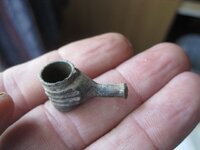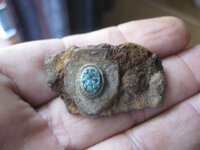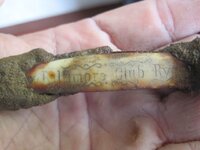U
Navigation
Install the app
How to install the app on iOS
Follow along with the video below to see how to install our site as a web app on your home screen.
Note: This feature may not be available in some browsers.
More options
You are using an out of date browser. It may not display this or other websites correctly.
You should upgrade or use an alternative browser.
You should upgrade or use an alternative browser.
mastereagle22
Silver Member
- May 15, 2007
- 4,909
- 31
- Detector(s) used
- E-trac, Explorer II, Xterra30, Whites Prizm IV
And it was always a family affair. Beginning in 1860, Hunter Baltimore Rye was made by William Lanahan and Son. In 1868, the Frank L. Wight Distilling Co. began production of Sherbrook, using a recipe perfected by ancestor John J. Wight. From 1872 until 1919, Thomas G. Carroll and Son were kept busy turning out Baltimore Club Rye, Carroll’s Carrollton and Return Rye. Perhaps the most storied of the Maryland ryes was Melrose, created by Henry “Harry” Paul Goldsborough in 1885. Not simply one rye, it was a blend of no fewer than five whiskeys, and took up to six months in its
In 1931, Henry Walters, the son of world-class art and whiskey collector William T. Walters, passed away, and an almost insignificant portion of the very large estate he left to his wife Sarah was his (and his father's) collection of Maryland Rye whiskey. Accumulated prior to prohibition, the many cases of full bottles had lain in the cellar of their home for decades, and they continued to do so. Mrs. Walters did not drink and was most likely unaware of the existence of these increasingly rare objects. She died in 1943, and they turned up as part of her estate sale, held in November of 1943 at the Ritz-Carlton Hotel on Park Avenue in New York City. In his definitive study on Maryland Rye whiskey for the Maryland Historical Society, Baltimore Sun editorialist and author James H. Bready notes that, ".. .of sixty-three lots catalogued and priced by Peter Greig of New York, the final dozen were 982 quarts and fifths of “Maryland Rye Whiskies”—specifically, Baltimore Club, Melvale (case-dated 1887, 1888, 1890, 1891), Orient (label-dated 1890, 1892) and Sherwood (stamped 1911).. .A small 1943 sticker was affixed to the back of each bottle. A few such certified Walters Sale relics, emptied, still turn up in the antiques market".
In 1931, Henry Walters, the son of world-class art and whiskey collector William T. Walters, passed away, and an almost insignificant portion of the very large estate he left to his wife Sarah was his (and his father's) collection of Maryland Rye whiskey. Accumulated prior to prohibition, the many cases of full bottles had lain in the cellar of their home for decades, and they continued to do so. Mrs. Walters did not drink and was most likely unaware of the existence of these increasingly rare objects. She died in 1943, and they turned up as part of her estate sale, held in November of 1943 at the Ritz-Carlton Hotel on Park Avenue in New York City. In his definitive study on Maryland Rye whiskey for the Maryland Historical Society, Baltimore Sun editorialist and author James H. Bready notes that, ".. .of sixty-three lots catalogued and priced by Peter Greig of New York, the final dozen were 982 quarts and fifths of “Maryland Rye Whiskies”—specifically, Baltimore Club, Melvale (case-dated 1887, 1888, 1890, 1891), Orient (label-dated 1890, 1892) and Sherwood (stamped 1911).. .A small 1943 sticker was affixed to the back of each bottle. A few such certified Walters Sale relics, emptied, still turn up in the antiques market".
Upvote
0
mastereagle22
Silver Member
- May 15, 2007
- 4,909
- 31
- Detector(s) used
- E-trac, Explorer II, Xterra30, Whites Prizm IV
Iron piece appears to be an arrow head with the turquois type stone in it ?
?
 ?
?
Upvote
0
Top Member Reactions
-
 3503
3503 -
 1985
1985 -
 1938
1938 -
 1192
1192 -
 1113
1113 -
 1015
1015 -
 870
870 -
 845
845 -
 818
818 -
 797
797 -
 745
745 -
 677
677 -
 579
579 -
 570
570 -
 497
497 -
 450
450 -
 433
433 -
E
415
-
 400
400 -
 390
390
Users who are viewing this thread
Total: 2 (members: 0, guests: 2)

 and the knife says "Baltimore Club Rye"
and the knife says "Baltimore Club Rye" 












